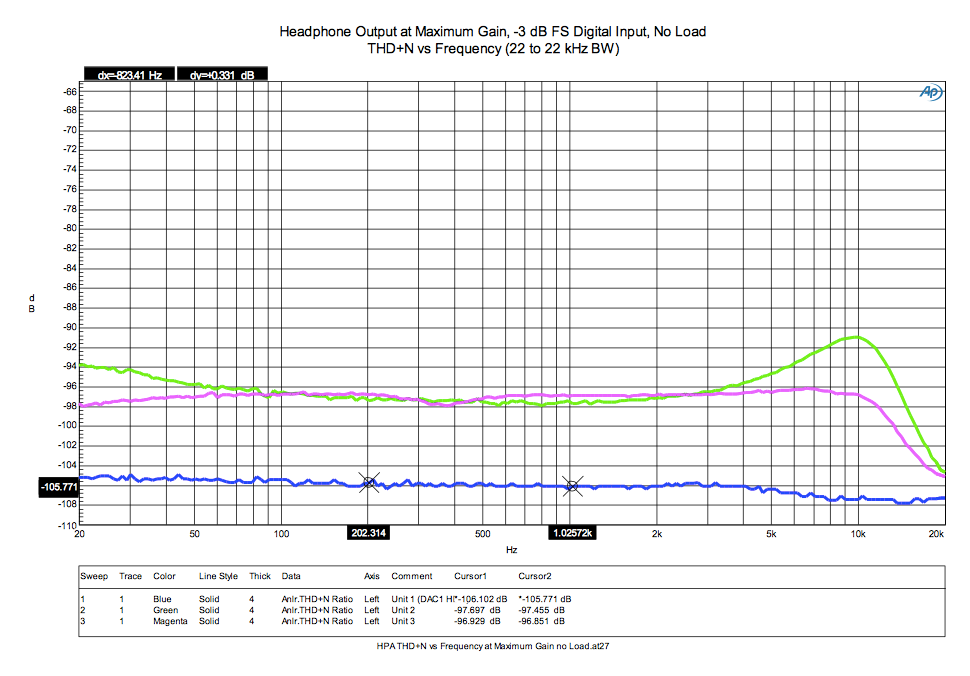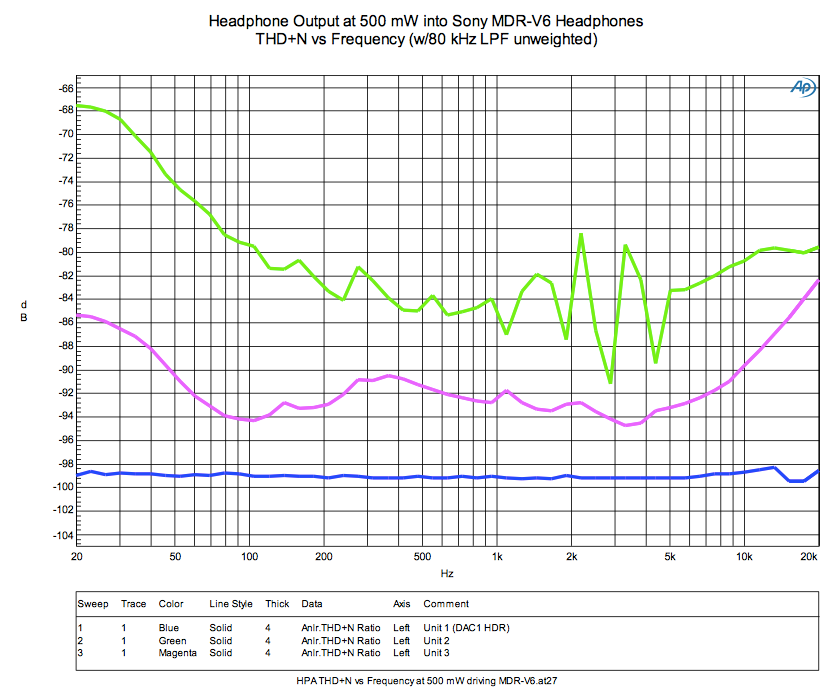Buy one component and save 10% on up to 2 cables. Buy 2 components and get 4 free cables. Free shipping on USA orders over $700.
Buy one component and save 10% on up to 2 cables. Buy 2 components and get 4 free cables. Free shipping on USA orders over $700.
Headphone Amplifiers - Part 1
by John Siau March 14, 2014

By John Siau
March 14, 2014
Headphone Amplifiers - Part 1
Specifications are Only Part of the Story!
A couple years ago, some of us at Benchmark noticed a weird discrepancy between our HPA2™ headphone amp (built into our DAC1 and DAC2) and some comparably-priced headphone amps. The advertised specifications of all the amps were basically the same, but they sounded noticeably different. Benchmark launched a detailed investigation to identify the differences. The results were surprising and are detailed in "An Examination of Headphone Amplifier Performance Specifications", a white paper by John Siau.
If you care to read the whole whitepaper, you can follow the link above. Otherwise, please continue reading the summary presented in this blog post. Either way, our findings were the same:
We tested three high-quality pro-audio headphone amplifiers with built-in D/A converters. All three had similar published specifications. All units are priced between $1000 and $2000. We verified that the manufacturer’s specifications were accurate, but we have shown that these published specifications are not sufficient to tell the whole story. In this case, the published specifications were not a good representation of typical operating conditions.
The key to the riddle is that all of the published measurements were made with an ideal resistive load. Performance changed dramatically when headphones were connected in place of the resistor loads. With actual headphones loading the amplifiers, the specifications mirrored what we had experienced in listening tests. There were significant differences in the measured performance of the three units when driving headphones, but not when driving resistive loads. We found that our subjective listening tests were validated by the measurements when the tests accurately reflected real-world conditions.
It would be nice if we could build headphones that would behave like an ideal resistor. This would make a headphone amplifier's job easy. Unfortunately, electro-mechanical transducers are far from ideal. The burden falls squarely on the headphone amplifier. As it turns out, headphone amplifiers are not created equal:
In order to make a fair test, we compared the HPA2™ (again, included with our DAC1 and DAC2) to comparably spec’d headphone amps costing between $1,000 to $2,000 - not inexpensive models you'd expect to be deficient. All these amplifiers had similar “ideal” specs, but how would they hold up in real-world tests? We wanted to find out.

You can see in the graph above, the ideal test, everything is basically even. None of the three amps show much distortion. Without actually running the signal into a load, the Total Harmonic Distortion + Noise (THD+N) is comparable. While the HPA2™ measure slightly better than the others, you probably wouldn't hear a difference between these amplifiers in this ideal world. These are the measurements/specifications that manufacturers show consumers.
 In our second test we added a 60-Ohm resistive load to simulate headphone loading. Notice that distortion begins to increase in the non-HPA2 amplifiers (green and magenta curves). In contrast, the performance of the HPA2™ is nearly unchanged when driving a 60-Ohm resistor (blue curve).
In our second test we added a 60-Ohm resistive load to simulate headphone loading. Notice that distortion begins to increase in the non-HPA2 amplifiers (green and magenta curves). In contrast, the performance of the HPA2™ is nearly unchanged when driving a 60-Ohm resistor (blue curve).

In our third test, we replaced the 60-Ohm resistor (ideal load) with a pair of 60-Ohm headphones. Distortion rose significantly in the non-Benchmark headphone amplifiers. The 60-Ohm headphones do not behave like 60-Ohm resistors. Clearly the other two amplifiers were having difficulty controlling the headphone transducers. In contrast, the HPA2™ measured almost the same as it did in the unloaded conditions (1st test).
This third graph shows the THD+N for the three amplifiers while driving a pair of Sony MDR-V6. The Sony headphones aren’t extremely hard to drive, but they do tax the performance of the non-Benchmark amplifiers.
All three headphone amplifiers have enough power to drive the MDR-V6 headphones at their 500 mW rated power. Nevertheless, units 2 and 3 were unable to fully damp the mechanical resonances of these popular headphones. Consequently, units 2 and 3 show significant distortion at low frequencies.
Units 2 and 3 produce audible levels of distortion when driving the popular Sony MDR-V6 headphones. Clearly these two amps are not able to maintain control over the headphone drivers. Distortion can color the voicing of the headphones and cause listener fatigue.This correlated with the original listening tests that prompted this investigation.
In conclusion, all three of these headphone amps have the same specifications under ideal loads, but they don’t perform the same when driving headphones.
Download the full white paper:
"An Examination of Headphone Amplifier Specifications" - John Siau
Recommended reading:
More information on headphones and headphone amplifiers can be found here
If you’d like to learn more, get in touch with someone at Benchmark, and we’d be happy to answer your questions. We work hard to develop products that perform and measure well under all real-world conditions - not just selected ideal conditions.
Also in Audio Application Notes

How Loud is the Distortion from Your Power Amplifier?
by John Siau August 08, 2025
Would you put a Washing Machine in your Listening Room?
If the answer is no, you may be surprised to discover that the distortion produced by your power amplifier may be louder than the noise produced by a major appliance.
Don't believe me? Take a look at Stereophile's test reports:
We selected 7 power amplifiers from Stereophile's top list of recommended amplifiers.
We took Stereophile's "THD+N vs. Power" plots for each, and replotted the data in a format that shows the loudness of the THD+N at the listening position.
The results are shocking!
Amplifier THD+N is louder than expected!
The distortion from your amplifier may be louder than a washing machine on the spin cycle, or it may be totally silent. How does yours perform? The answer is hidden in Stereophile's THD+N plots.
This application note reveals the hidden truth:
"The Distortion from your Power Amplifier may be Louder than a Washing Machine!"
I know, it sounds crazy, but this is what the measurements show!

Interpolator Overload Distortion
by John Siau November 20, 2024
Most digital playback devices include digital interpolators. These interpolators increase the sample rate of the incoming audio to improve the performance of the playback system. Interpolators are essential in oversampled sigma-delta D/A converters, and in sample rate converters. In general, interpolators have vastly improved the performance of audio D/A converters by eliminating the need for analog brick wall filters. Nevertheless, digital interpolators have brick wall digital filters that can produce unique distortion signatures when they are overloaded.
10% Distortion
An interpolator that performs wonderfully when tested with standard test tones, may overload severely when playing the inter-sample musical peaks that are captured on a typical CD. In our tests, we observed THD+N levels exceeding 10% while interpolator overloads were occurring. The highest levels were produced by devices that included ASRC sample rate converters.

Audiophile Snake Oil
by John Siau April 05, 2024
The Audiophile Wild West
Audiophiles live in the wild west. $495 will buy an "audiophile fuse" to replace the $1 generic fuse that came in your audio amplifier. $10,000 will buy a set of "audiophile speaker cables" to replace the $20 wires you purchased at the local hardware store. We are told that these $10,000 cables can be improved if we add a set of $300 "cable elevators" to dampen vibrations. You didn't even know that you needed elevators! And let's not forget to budget at least $200 for each of the "isolation platforms" we will need under our electronic components. Furthermore, it seems that any so-called "audiophile power cord" that costs less than $100, does not belong in a high-end system. And, if cost is no object, there are premium versions of each that can be purchased by the most discerning customers. A top-of-the line power cord could run $5000. One magazine claims that "the majority of listeners were able to hear the difference between a $5 power cable and a $5,000 power cord". Can you hear the difference? If not, are you really an audiophile?

